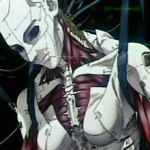by Andrew Jamieson
This year sees Ghost In The Shell, the manga (a Japanese comic for the uninitiated), turn twenty-eight years old. The impending release of Hollywood’s take on author-artist Masamune Shirow’s defining work – and the subsequent animated adaptations – sent me back to his original manga, and the very first anime feature, director Mamoru Oshii’s seminal 1995 film of the same name. The latter was hailed for its stark vision of the future, endorsed at the time by the likes of acclaimed American director, James Cameron (of Terminator, Aliens, Titanic, and Avatar fame). A cyberpunk science-fiction fable about a government special forces cyborg unit, Ghost In The Shell started life in serialised format for Japan’s Young Magazine from 1989 to 1990, duly released in collected form the year after, achieving enough initial popularity and success to build its legacy upon. A sequel was serialised in 1997 for the same magazine, entitled Ghost In The Shell 2: Man-Machine Interface. Culled chapters from this sequel were themselves released in 2003 as Ghost In The Shell 1.5: Human-Error Processor.

The original 1995 anime film is an excellent adaptation of Shirow’s somewhat rambling source material, and dials up the mood and atmosphere of the manga, whilst reducing the political intrigue. There is a more quirky nature to the manga and this is largely missing from Mamoru Oshii’s film. However, Shirow’s genius lies in the detail that his future vision depicts; narrative and plot seem like a secondary bi-product to his characters and their technology. Oshii’s film strips away the meandering nature of the manga, distilling its core themes of identity and isolation into a lean cyberpunk thriller that, twenty-two years later, still retains the visual innovation and atmospheric storytelling that sees it hailed on a regular basis as one of the greatest anime films of all time. Oshii has in the past described himself more interested in visual style and action sequences rather than story, and whilst Ghost in The Shell upholds this somewhat, Oshii sells himself short, and the film is by no means a hi-octane action-fest. The film is full of contemplative moments; one of the standouts for me is a montage sequence that runs for approximately five to ten minutes that focuses on the streets and skyline of Niihama Prefecture (the film’s fictional Japanese city setting), accompanied by Kenji Kawai’s atmospheric score. This sequence is all about mood and infuses and emphasizes the film’s setting and themes. Oshii is a more skilled storyteller than he gives himself credit for.
Mamoru Oshii was an accomplished director in his own right prior to Ghost In The Shell, the Patlabor tv series and films having established his reputation in the late eighties and early nineties, alongside his ongoing SF epic, the Kerberos Saga. The success of Ghost In The Shell inevitably lured him back and he returned to familiar ground in 2004 with Ghost In The Shell 2: Innocence, a sequel that was not a direct adaptation of Masamune Shirow’s manga sequel, Man-Machine Interface. Oshii called on the experience, and facilities, of his old associates

Hayao Miyazaki and Isao Takahata at Studio Ghibli (Oshii had worked alongside these two for a brief spell during the eighties), who ultimately became integral to the completion of Innocence, alongside animation house, Production I.G, who worked on the original Ghost In The Shell. Innocence received mostly positive reviews on its release, and was hailed for its visual accomplishments, but is a very different film from its predecessor, although they do share common themes. Whereas the first feels fresh in its exploration of its ideas, Innocence treads familiar territory with a murder mystery angle. Innocence was selected for the prestigious Palme d’Or at the 2004 Cannes Film Festival, making it at the time the only anime to have ever been selected for such distinction.
2008 saw Oshii once more return to the Ghost In The Shell franchise, to release an upgraded edition of his original 1995 film, with various sequences replaced with CGI, and a fresh audio track. Whilst the CGI is impressive, Ghost In The Shell 2.0 Redux is a jarring experience, the new CGI elements at odds against the standard cell animation. It’s an interesting experiment but by no means essential viewing.
Ghost In The Shell has also been adapted for television on two occasions. From 2002 to 2005, Ghost In The Shell: Stand Alone Complex, from Production I.G (also behind the two feature films) ran for two seasons and a sequel feature, Solid State Society. This show, rather than being a remake, took the manga’s core ideas and characters and gave them a different spin; most tellingly, out goes the antagonist of The Puppet Master, in comes The Laughing Man. Character design and setting remained faithful to the feature-length animes. The show’s director, Kenji Kamiyama, described Stand Alone Complex as a ‘relative’ to the other iterations. Stand Alone Complex reintroduced some of Shirow’s humour in the form of the robotic tanks, the Tachikomas, a welcome injection of levity in the otherwise serious main storyline. Shirow himself worked on the show, and gave his approval to the series scripts, and his involvement shines through. Mamoru Oshii also returned and oversaw some of the second series. Stand Alone Complex is an excellent exploration of the Ghost In The Shell mythos, and arguably a more rewarding experience than the two anime films.

Ghost In The Shell: Arise comprises a series of feature-length animes, given theatrical release in Japan from July 2013 to August 2015. In the West these films were released on dvd and blu-ray. Once more animated by Production I.G, Arise is notable in that it is, yes, another re-imagining of the core story, but that this time around the plot is set before main character, Major Kusanagi, joins Section 9, functioning as a prequel of sorts. The other slightly more bold choice taken by the production is in its redesign of the characters, with Kusanagi’s design in particular deviating from the classic look of the previous show and films. The four Arise films were restructured for Japanese television – retitled Ghost In The Shell: Arise – Alternative Architecture – including two new episodes, and this reformatting preceded the sequel feature, Ghost In The Shell: The New Movie. The films and the show were generally received well but suffered in comparison to the other versions of Ghost In The Shell, and Arise and The New Movie did not garner the attention or acclaim of the movies or previous show, Stand Alone Complex.
March 31st sees the release of the latest version of Ghost In The Shell, and director Rupert Sanders, having been attached to the project since 2009, has indicated that his version will incorporate elements from across the various mangas, films and shows. The director’s previous film, Snow White and the Huntsman, showcased his flair for inventive visuals, but it remains to be seen whether his take on Shirow’s story and characters brings anything fresh to the formula to reignite a franchise that has been stuck in a regular mode of recycling past glories.
Ghost In The Shell, and Ghost In The Shell 2: Innocence, as well as Stand Alone Complex, have all been re-released this month on dvd and blu-ray. The new film of Ghost In The Shell, starring Scarlett Johansson, is out in selected cinemas from Thursday 30th March.
- The Red Turtle (2017) - 16th June 2017
- Pirates of the Caribbean: Salazar’s Revenge (2017) - 31st May 2017
- Alien: Covenant (2017) - 15th May 2017
